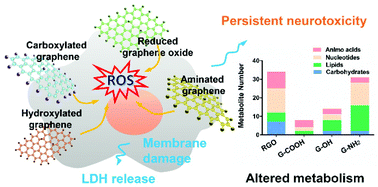Elucidating the mechanism of the surface functionalization dependent neurotoxicity of graphene family nanomaterials†
Abstract
Graphene family nanomaterials (GFNs) have shown great potential for biological and environmental applications; however, their future use has been debated due to their reported potential neurotoxicity. Moreover, the effects of surface functionalization on their biological end points are largely unknown. Here, we compared the effects of reduced graphene oxide (RGO), and carboxylated (G-COOH), hydroxylated (G-OH) and aminated (G-NH2) graphene nanosheets on human neuroblastoma cells (SK-N-SH). All GFNs inhibited cellular growth at concentrations of 0.1–10 mg L−1 after 24 h exposure. The toxicity was attenuated over longer exposure times, with the exception of G-NH2. Although the overall acute toxicity followed the order: G-OH ≈ G-COOH > RGO > G-NH2, G-NH2 induced more persistent toxicity and more metabolic disturbance compared to the other GFNs, with lipid and carbohydrate metabolism being the most affected. The potential for physical disruption of the lipid membrane and oxidative damage induced by GFNs varied with different functionalization, which accounts for the observed differences in neurotoxicity. This study provides significant insights into the neurological effects of GFNs, and suggests that G-NH2 is not as safe as reported in many previous studies. The neurological effect of GFNs over longer term exposure should be considered in future studies.

- This article is part of the themed collection: 2020 Nanoscale HOT Article Collection


 Please wait while we load your content...
Please wait while we load your content...